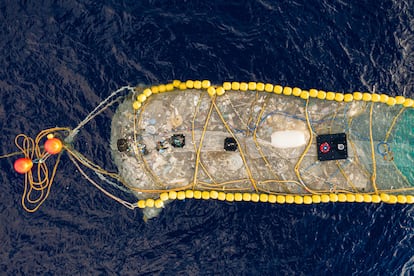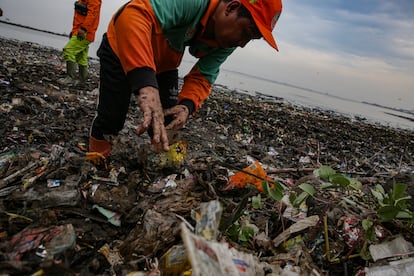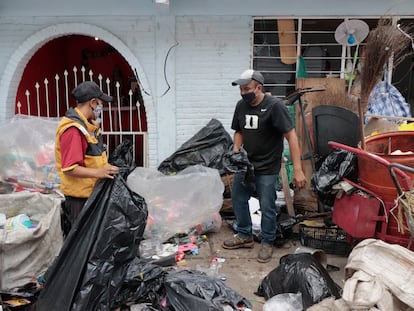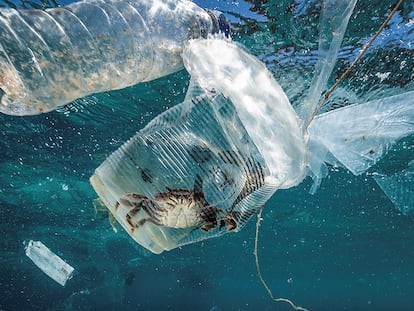The amount of plastic that reaches the sea is ten times less than previously thought, but that is not good news
The 3.4 million tons of polymers floating on the surface of the ocean indicate that the material remains in the water for years longer

The good news is that, according to a new study, some 500,000 tons of plastic — over ten times less than previous estimates — reach the sea every year, according to a new study. The bad news is that this plastic lasts longer than it was believed to, sometimes decades longer. New research, published in the scientific journal Nature Geoscience, estimates that there are 3.4 million tons of plastic floating in the ocean, but there must be far more at the ocean floor and ingested by marine animals.
A good portion of the 8.3 billion tons of plastic that people have made since they learned to do so has ended up in the ocean. It is difficult to give exact or even approximate figures for this problem. We know almost to the gram how many tons of these polymers are produced per year: 461 million in 2020. We also know the approximate amount that is recycled. But the certainty ends there: we don’t know how much plastic ends up being burned in landfills or winds up in rivers and reaches the ocean from there.
For a little over a decade, between environmentalists and scientists, several organizations — including 5Gyres, the Tara Ocean Foundation and Surfing for Science — have conducted expeditions and campaigns in which they collect the plastic they find on their journeys. Then, based on the area and what they collected, they estimate the quantity and mass of plastic materials.
Supported by a new mathematical model using 22,000 measurements from coastlines and sea surfaces and depths, a group of scientists has now recalculated the key figures for the flow of plastics. According to the new study’s lead author Mikael Kaandorp, of the Institute for Atmospheric and Marine Research at the University of Utrecht in the Netherlands, the researchers’ goal was to end the mystery of missing plastic. “Based on studies from 2014 and 2015, it was thought that between 4,000 and 12,000 kilotons [one kiloton is 1,000 tons] of plastic reaches the ocean every year, with only about 250 kilotons floating,” he says. “That would mean an incredible amount of plastic disappears every year, so we think our new numbers — 500 kilotons of input and around 3,400 kilotons of plastic in the water — make much more sense,” adds Kaandorp, who is also a researcher at the IBG-3 Institute of Bio and Geosciences in Jülich, Germany.

The new calculations detail the origins of marine plastics. Around 40% enters from the coast. “We can think of plastic waste that is poorly managed near the coast, like leaky landfills. Or maybe [it’s] waste thrown into the sea by rain runoff in coastal cities or blown into the ocean by the wind,” Kaandorp details. But the distribution of the rest of the plastic stands out. Almost half of petroleum derivative waste comes from fishing, mostly from fishing nets. And only 12% would come from rivers.
As for the plastic floating in the sea, the researchers estimate that there must be between 3 and 3.4 million tons on the surface. The vast majority of this plastic is relatively large, over 25 millimeters in size, and tends to be concentrated in so-called plastic islands, collections of garbage that are formed by the sea currents in the so-called ocean gyres. The new research’s figure is more than double the estimates of previous studies, which left it at a quarter of a million. The paper’s authors believe that the plastic’s size and concentration make it feasible to remove all of this artificial material from the sea.
But the amount of plastics on the ocean floor must be far greater. According to the new study, almost half of the accumulated plastic from previous years ends up on the seabed, forming part of the sediment at a rate of 220,000 tons per year. Going back to the 1950s,when mass production began, the researchers calculate that there must be 6.2 million tons of plastic on the ocean floor that floated into the sea. But this transit between the surface and the bottom of the sea remains the greatest unknown. The problem is that it is not easy to trace plastics (even if water bottle caps still bearing a manufacturer’s name have been found in the Arctic).
José María Alsina, of the Polytechnic University of Catalonia’s Maritime Engineering Laboratory, gives the example of a water bottle: “When it comes from the river it is not the same as when it has been thrown from a boat. It is necessary to take into account where it ends up, whether on the shore [or] in the oceanic gyres, and whether it sinks. Degradation by solar radiation and erosion by sand also play a role. And [then] there is biofouling, the incrustation of microalgae in the plastic [which affects its buoyancy]... Everything makes it difficult to know where that bottle of water will end up.”

Previous studies have estimated that only around 3% of the plastic in the sea is floating on the surface. The vast majority of plastics would be at the bottom. The problem, Alsina says, is that “over 99% of the measurements have been done on the surface [using] floating plastic, there’s hardly any data from the [ocean’s] depths.” Tracking plastics at the bottom of the ocean requires special vehicles and technologies that are not readily accessible. For example, the new study is supported by more than 20,000 measurements, but only 120 come from the sea floor.
Another factor also complicates the calculations: there is a huge mass of water, thousands of meters deep, between the surface and the bottom, and nobody knows how much plastic is there. In theory, this material floats. But that’s not always the case. Some of the modern plastics like PVC and PET containers can have a greater weight than salt water and sink slowly. A work reviewing previous research published last year estimated that there were 170 million tons at the bottom of the sea, interspersed with the sediment (the estimate range is between 25 and 900 tons, which indicates the uncertainty that exists).
Plastic that doesn’t float or sink
Carlos Duarte, an oceanographer at Saudi Arabia’s King Abdullah University of Science and Technology, led that work on plastics on the seabed. Researchers then concluded that over 95% of the mass of plastics that has entered the ocean is buried on the seabed, “which denotes very efficient sedimentation processes, the nature of which remains to be resolved and which this article does not clarify,” comments Duarte, who is surprised by some of the figures they obtained. Duarte’s study also mentioned processes about which we know very little that cause some plastics not to float or sink; in their cycle in the sea, little pieces of plastic can sink under the weight of the biofilm that forms on its surface. But as they sink, the amount of light they receive decreases, which would kill the algae. In addition, these biological materials are formed primarily by silicates and carbonates, which dissolve in cold water. So, there could be a huge amount of plastic bobbing up and down that hasn’t been accounted for.
University of Cádiz biologist Andrés Cózar is a leading expert on plastics in the sea. A pioneer in calculating the amount of this material in the ocean, he was the first to mention the mystery of missing plastic. According to Cózar, the problem with Kaandorp’s work is that “there are two ways to make these numbers add up. One is by making the residence time of plastics on the ocean surface very short, that is, the plastic that enters is quickly removed and goes to the coasts and the ocean floor. That approach has been common in previous studies. The second way to adjust the numbers is that the inputs from rivers are much less than those estimated up to now. And that is what this new study has done. Mathematically, both options are valid.”
According to Cózar, the same problem remains: “We still do not have calculations of the surface’s plastic load or of inputs from rivers that are precise enough to choose one option or the other. In other words, the uncertainty range is so wide that it allows both mathematical adjustments.” But if the latest calculations from Kaandorp’s work are valid, that implies that they “indirectly locate large amounts of plastic inland,” Cózar explains.
The amount of new plastic entering the sea could be much less than previously believed, but according to the Kaandorp group’s calculations, it is growing at a rate of 4% per year. If nothing is done to reduce or remove it, the plastic floating in the sea will double in two decades. If the researchers’ numbers are correct, plastics will remain as macroplastic, microplastic and simple plastic on the surface, on the shores, on the seabed and in the ocean’s medium depths for years to come.
Sign up for our weekly newsletter to get more English-language news coverage from EL PAÍS USA Edition
Tu suscripción se está usando en otro dispositivo
¿Quieres añadir otro usuario a tu suscripción?
Si continúas leyendo en este dispositivo, no se podrá leer en el otro.
FlechaTu suscripción se está usando en otro dispositivo y solo puedes acceder a EL PAÍS desde un dispositivo a la vez.
Si quieres compartir tu cuenta, cambia tu suscripción a la modalidad Premium, así podrás añadir otro usuario. Cada uno accederá con su propia cuenta de email, lo que os permitirá personalizar vuestra experiencia en EL PAÍS.
¿Tienes una suscripción de empresa? Accede aquí para contratar más cuentas.
En el caso de no saber quién está usando tu cuenta, te recomendamos cambiar tu contraseña aquí.
Si decides continuar compartiendo tu cuenta, este mensaje se mostrará en tu dispositivo y en el de la otra persona que está usando tu cuenta de forma indefinida, afectando a tu experiencia de lectura. Puedes consultar aquí los términos y condiciones de la suscripción digital.
More information

Plastic colonialism: Mexico’s waste imports from the US double in two years
Archived In
Últimas noticias
The metaverse, four years later: Is it finished or just at a standstill?
$3,000 and a plane ticket: The United States increases incentives for migrants to self-deport before the end of the year
Charles Dubouloz, mountaineering star, retires at 36 with a farewell tour inspired by Walter Bonatti
From the White House to diplomatic gifts: Lego wins over adult fans, brick by brick
Most viewed
- The low-cost creative revolution: How technology is making art accessible to everyone
- Families demand repatriation of bodies of Colombians who died in Ukraine: ‘This war is a slaughterhouse for foreigners’
- Christian Louboutin: ‘Young people don’t want to be like their parents. And if their parents wear sneakers, they’re going to look for something else’
- All the effects of gentrification in one corner of Mexico’s Colonia Roma
- Christmas loses its festive spirit: ICE fears cast shadow over religious celebrations










































